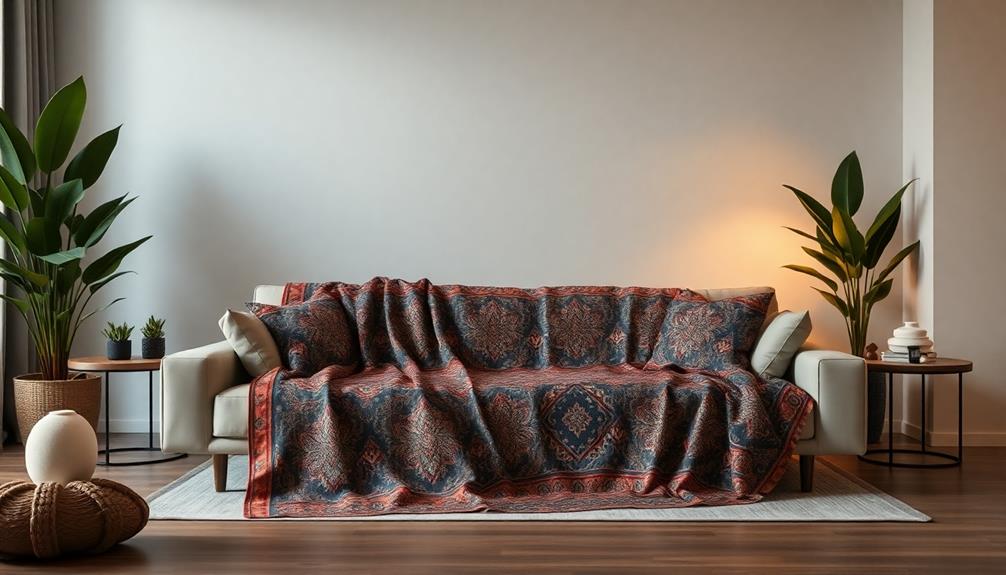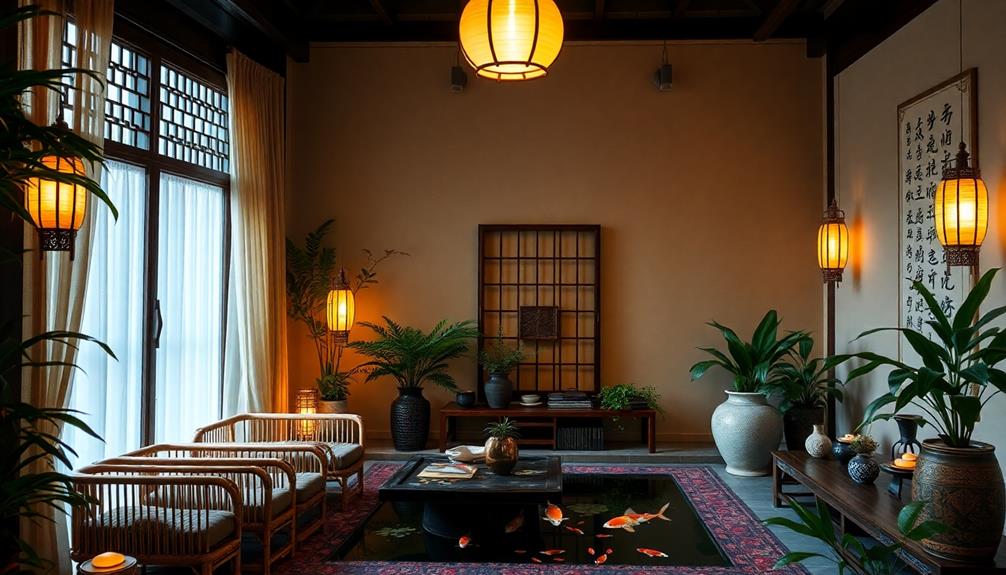Batik, with a vibrant history over 2,000 years old, brings unique cultural stories into your modern interiors. Originating from various cultures, especially Indonesia, each intricate pattern symbolizes deep meanings and traditions. This artistry shines in contemporary design, fitting beautifully in styles from bohemian to minimalist. You can find batik in textiles like cushions and curtains, adding a splash of color and narrative to your space. Plus, the growing trend for sustainable, handcrafted decor makes batik increasingly popular. There's so much more to discover about how batik can enhance your home aesthetic and its ongoing global influence.
Key Takeaways
- Batik, with origins over 2,000 years old, embodies rich cultural stories through intricate patterns and motifs significant to various societies.
- Traditional techniques, such as hand-drawn and stamped batik, showcase artisan craftsmanship, adding authenticity to modern decor.
- Batik's vibrant colors and unique designs seamlessly integrate into contemporary interiors, enhancing styles like bohemian, minimalist, and eclectic.
- The artisanal appeal of batik attracts consumers who prioritize sustainable, handcrafted products in their modern living spaces.
- Global recognition, bolstered by UNESCO's designation, has increased batik's popularity, inspiring contemporary designers to merge traditional artistry with modern aesthetics.
The Origins of Batik
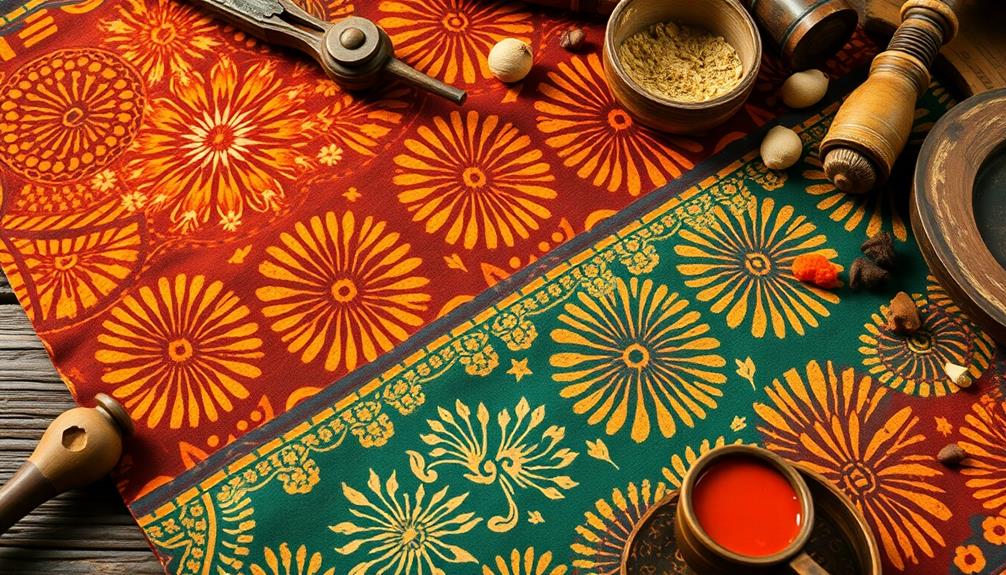
Batik's origins stretch back over 2,000 years, weaving through cultures across the Far East, Middle East, Central Asia, and India. This ancient art form employs wax-resist dyeing techniques that have stood the test of time.
While you might associate batik primarily with Indonesia, particularly Java, its influence spans many regions. In fact, historical records show that during the Sui Dynasty in China and the Nara period in Japan, batik was already being practiced, showcasing its wide geographical reach.
The vibrant artistry of batik reflects rich cultural stories, similar to the unique designs found in Indonesian decor masks that tell tales of local traditions. The intricate patterns and motifs of batik not only reflect the cultural stories of various communities but also highlight the craft's adaptability.
For instance, the Yoruba people in Nigeria and Senegal have preserved traditional batik techniques, emphasizing the art's significance across continents. In recognition of its rich heritage, UNESCO designated batik as an Intangible Cultural Heritage of Humanity in 2009, further underscoring its importance in the global textile landscape.
Understanding batik's origins helps you appreciate its beauty and cultural depth, making it a perfect addition to your modern interiors, connecting the past with the present.
Traditional Techniques and Processes
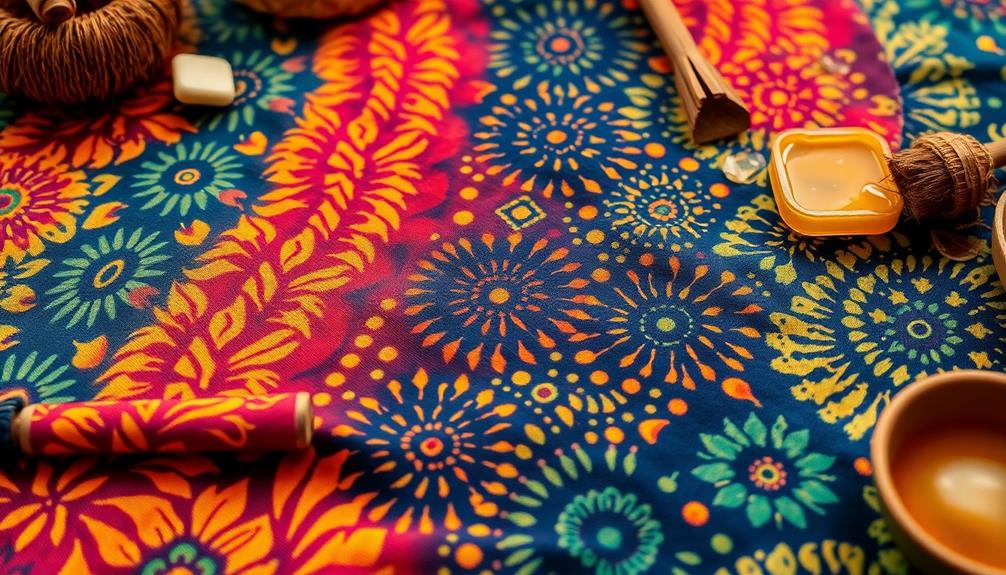
When it comes to traditional batik techniques, you'll find two primary methods: the hand-drawn Batik Tulis and the stamped Batik Cap.
Each technique offers unique aesthetics and production times, with Tulis showcasing painstaking craftsmanship while Cap allows for quicker, consistent patterns.
The intricate designs often depict local myths and folklore, reflecting the rich cultural heritage of Indonesia that resonates well with those who appreciate Indonesian artistry.
You might also explore painting techniques that add another layer of creativity to batik's rich heritage.
Hand-Drawn Batik Tulis
In the world of textile art, few techniques rival the intricate beauty of hand-drawn Batik Tulis. This traditional method employs a canting tool to create detailed designs, reflecting the artisan's skill and creativity. The process is time-consuming, often taking several days to a year, depending on the complexity of the patterns and dyeing involved. Each layer of hot wax and subsequent dye bath adds depth and vibrancy to the fabric.
The wax-resist technique is essential in Batik Tulis, allowing artisans to craft unique and ornate patterns that tell stories or convey cultural significance. Specific motifs in Batik Tulis can symbolize social status, nature, and virtues within Indonesian society, making each piece a rich tapestry of meaning.
| Aspect | Description |
|---|---|
| Art Form | Hand-drawn designs using a canting tool |
| Cultural Significance | Motifs symbolizing status, nature, and virtues |
| Technique | Wax-resist technique with hot wax and dyeing |
Stamped Batik Cap
Often celebrated for its efficiency, Stamped Batik Cap employs a copper stamp, or tjap, to apply hot wax onto fabric. This method allows you to create beautiful textile art quickly, making it a favorite for artisans looking to produce repetitive designs.
Unlike the labor-intensive Batik Tulis, Stamped Batik Cap enhances production efficiency while still achieving uniformity in patterns and vibrant colors. Additionally, the vibrant colors and intricate designs of batik fabrics can complement various home decor styles, similar to how Indonesian decor masks enrich interior aesthetics.
Artisans skilled in this technique can explore a broader range of designs, catering to contemporary tastes and market demands. This accessibility has made stamped batik cap fabrics incredibly popular in both local and global markets, perfect for fashion and home decor.
Recognized by UNESCO, the practice not only showcases Indonesia's rich heritage but also plays an essential role in preserving batik techniques that have been passed down through generations.
Painting Techniques in Batik
While Stamped Batik Cap showcases efficiency and uniformity, painting techniques in batik offer artisans a canvas for creativity and intricate artistry.
In traditional batik painting, artists apply hot wax onto fabric using a canting tool, creating beautiful designs that resist dye penetration during the dying process. This wax-resist technique allows for a stunning array of intricate patterns, as multiple dye baths enhance the visual depth and richness of colors.
Additionally, batik's versatility allows it to complement various interior styles, from modern to traditional, making it a perfect choice for enhancing living spaces with vibrant colors and intricate patterns.
Batik Lukis, a notable painting technique, enables artists to use brushes and dyes directly on the fabric. This method results in unique and modern motifs, diverging from traditional motifs found in Batik Tulis and Batik Cap. The vibrant colors often come from natural dyes derived from plants and minerals, emphasizing sustainability in the art of batik.
Mastering these batik techniques requires skilled hands and a deep understanding of the craft, which has been preserved through generations.
This dedication not only maintains cultural heritage but also bridges traditional artistry with modern fashion, making batik a timeless choice for contemporary interiors.
Embrace the beauty of painted batik and let its intricate designs inspire your space.
Cultural Significance of Batik

Batik's rich history and cultural significance make it more than just a decorative textile; it's a vibrant tapestry of Indonesian heritage. This ancient art form, over 2000 years old, embodies deep symbolic meanings intertwined with social status and cultural beliefs. Each batik motif tells a story, reflecting the diverse narratives of Indonesian culture.
| Batik Motif | Symbolic Meaning |
|---|---|
| Parang | Power and protection |
| Kawung | Fertility and prosperity |
| Mega Mendung | Clouds and harmony |
Batik textiles are integral to Indonesian identity, often adorning individuals during significant life events like weddings and ceremonies. This practice reinforces a strong sense of community and shared heritage. In 2009, UNESCO recognized batik as an Intangible Cultural Heritage of Humanity, emphasizing its cultural significance and the urgent need for preservation amid modern influences.
The vibrant patterns of batik also reflect regional identities, with distinct styles varying across Indonesia's islands. Engaging with these traditional patterns not only connects you to a rich history but also enhances your appreciation for the cultural narratives that each piece holds.
Batik in Modern Design

Integrating batik into modern design breathes new life into interior spaces, transforming them with vibrant colors and intricate patterns. You'll find that batik enhances contemporary settings, making it a popular choice for curtains, cushions, and upholstery. Each piece tells a story, allowing for cultural storytelling and artistic expression that resonates with your personal style. It’s not just about adding a pop of color or a unique pattern; it’s about how batik can enhance decor, giving it a sense of depth and history. The traditional craftsmanship involved in creating batik adds a touch of authenticity and craftsmanship to any space, elevating the overall design. Whether you choose to incorporate batik through accent pieces or as the main focal point, its ability to enhance decor is undeniable.
This is particularly evident when batik is combined with traditional Indonesian style home decor, where it complements natural materials like wood and bamboo to create a harmonious atmosphere.
Luxury brands, like Schumacher, have recognized batik's timeless appeal, featuring batik-inspired designs in their collections. This showcases the fabric's versatility, seamlessly blending traditional craftsmanship with modern aesthetics.
Antique batik pieces can also serve as striking focal points in your home, evoking a sense of historical richness and cultural depth.
As you explore interior design, consider how batik can adapt to various themes—whether it's bohemian, minimalist, or eclectic. Designers are continuously innovating, finding new applications for batik that keep it relevant and exciting.
Trends Influencing Batik Today
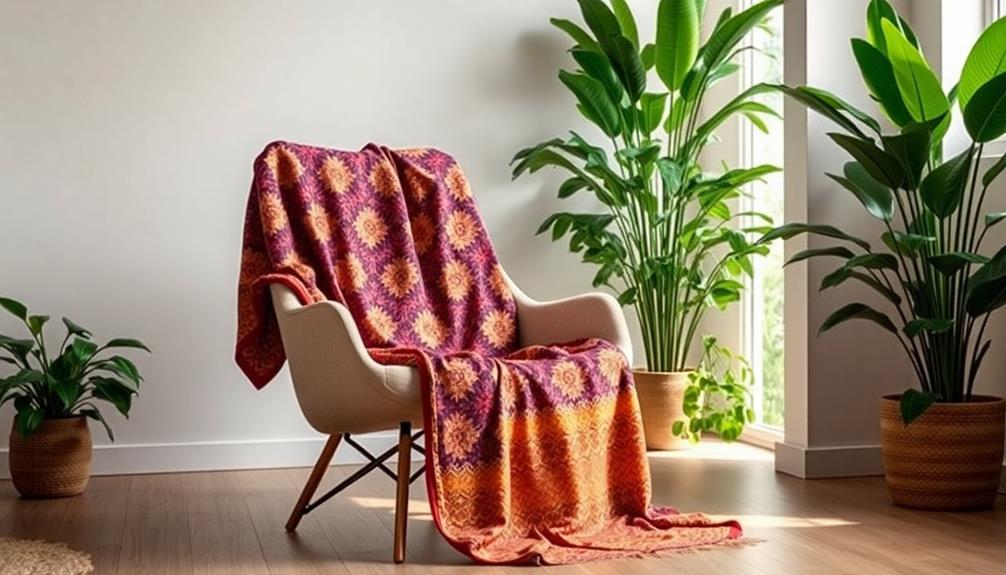
The growing interest in batik today is largely fueled by contemporary designers who breathe new life into traditional motifs, making them appealing to younger audiences. This resurgence has transformed batik into a staple of modern fashion and interior design, showcasing its vibrant colors and intricate craftsmanship.
Additionally, the incorporation of batik into Balinese design characteristics enhances its relevance, as both celebrate craftsmanship and a connection to nature. Here are some trends influencing batik:
- Artisanal Appeal: Handcrafted batik is celebrated for its unique cultural heritage, attracting those who value sustainable products.
- Luxury Collections: Brands like Schumacher are integrating batik-inspired designs into high-end interiors, elevating its status in luxury decor.
- Social Media Influence: Platforms allow artisans to reach a global audience, showcasing their work and connecting with fans of unique textile designs.
- UNESCO Recognition: The designation of batik as an Intangible Cultural Heritage has raised awareness, promoting preservation and innovative adaptations.
These trends not only revive interest in batik but also highlight its versatility, allowing it to flourish in various modern contexts.
As you explore batik for your interiors, consider how these elements can enhance your space while honoring the craftsmanship behind this beautiful art form.
Global Impact and Recognition
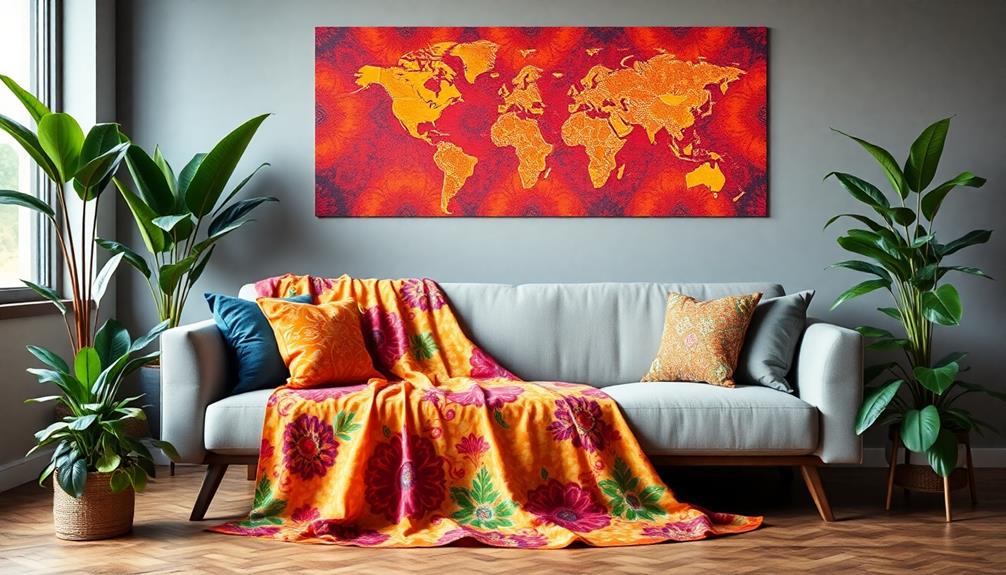
Batik's recognition as an Intangible Cultural Heritage by UNESCO highlights its global importance and artistic value.
This traditional textile art form, much like the principles of tropical contemporary architecture, emphasizes a deep connection to nature and the environment through vibrant patterns and colors.
You've likely noticed a surge in its popularity, with contemporary designers reimagining traditional techniques for modern aesthetics.
This fusion not only celebrates cultural heritage but also keeps batik relevant in today's design landscape.
Global Popularity Surge
Since the 19th century, batik has captured the imagination of artists and designers worldwide, thanks in part to European traders showcasing it in museums. This exposure sparked a global interest that has led to a remarkable revival of this traditional craft.
By the 1960s, artists were diving into wax-resist dyeing techniques, reawakening appreciation for batik. Its unique patterns can even complement various decor styles, such as combining aesthetic and nautical room decor or adding a touch of richness to dark academia settings.
Key factors in batik's global popularity surge include:
- The establishment of the Batik Guild in London in 1986, which supports batik artists.
- UNESCO's recognition of batik as an Intangible Cultural Heritage of Humanity in 2009, highlighting its cultural significance.
- Modern Indonesian designers innovating batik styles to appeal to younger audiences.
- Increased integration of batik into contemporary interiors, making it a fashionable choice.
Through these developments, batik has transcended its traditional roots, becoming a staple in modern design.
Its vibrant colors and intricate patterns attract both artists and designers, ensuring that batik remains relevant in global culture. As you explore your own interiors, consider how batik can enrich your space while honoring its rich heritage.
Cultural Heritage Recognition
Recognizing batik as an Intangible Cultural Heritage of Humanity in 2009 marked a pivotal moment in the appreciation of this traditional art form. This UNESCO designation highlighted batik's significance in preserving cultural heritage and craftsmanship, emphasizing its role in showcasing the skills of artisans who create intricate designs with vibrant colors.
The rich cultural heritage of Southeast Asia, reflected in batik, also influences the use of vibrant colors and intricate patterns in modern decor key elements in decor. Since then, batik has gained global recognition, appearing in exhibitions and fashion shows that celebrate its rich history and artistic value.
The Batik Guild, founded in London in 1986, has been instrumental in promoting batik arts and nurturing a community of enthusiasts and artisans worldwide.
Today, contemporary artists and designers draw inspiration from traditional batik techniques, revitalizing the craft for modern audiences. This fusion of traditional artistry with contemporary aesthetics has led to batik's integration into global fashion trends, with luxury brands incorporating batik-inspired patterns into their collections.
As you explore the world of batik, you'll see how its vibrant colors and unique designs not only carry historical significance but also resonate with modern interior aesthetics, making it a perfect choice for anyone looking to add a touch of cultural richness to their space.
Frequently Asked Questions
What Is the Origin of Modern Batik?
Modern batik originates from ancient wax-resist dyeing techniques that emerged over 2,000 years ago, particularly flourishing in Indonesia. You'll find it incorporates traditional artistry with contemporary design, creating unique patterns that reflect deep cultural significance.
Why Is Batik so Special?
Batik's special because it combines vibrant colors with intricate patterns, each telling a unique story. You'll appreciate its cultural significance and the craftsmanship behind it, making any space feel more elegant and rich in history.
What Is the Uniqueness of Batik?
Imagine wearing a story woven in fabric. Batik's uniqueness lies in its intricate wax-resist designs, each telling a tale of culture and craftsmanship. You're not just adorning yourself; you're showcasing art that connects generations.
What Is the History of the Batika?
Batik's history spans over 2,000 years, originating in Indonesia. You'll discover its roots in various ancient cultures, evolving through colonial influences, symbolizing cultural identity, and showcasing intricate patterns that reflect social status and meaning.
Conclusion
Batik's rich history and vibrant techniques make it an ideal choice for modern interiors, blending tradition with contemporary style. As you explore this art form, you'll find that its cultural significance adds depth to your space. Why settle for ordinary when you can embrace a piece of history that tells a story? By incorporating batik into your home, you not only enhance your décor but also celebrate a global tradition that continues to inspire and connect us all.
